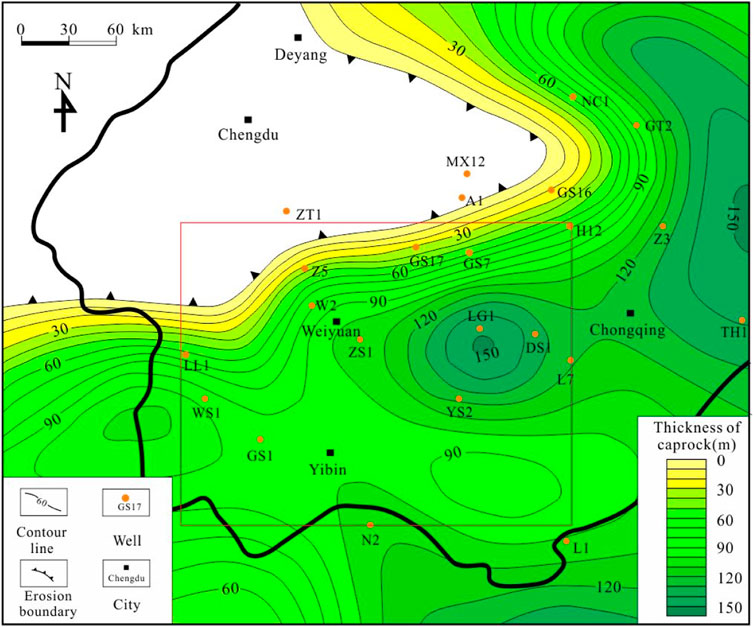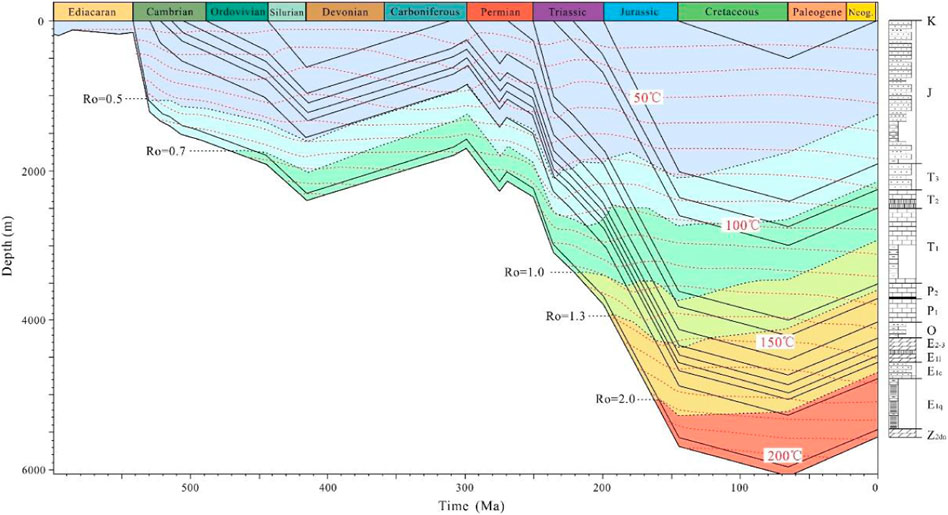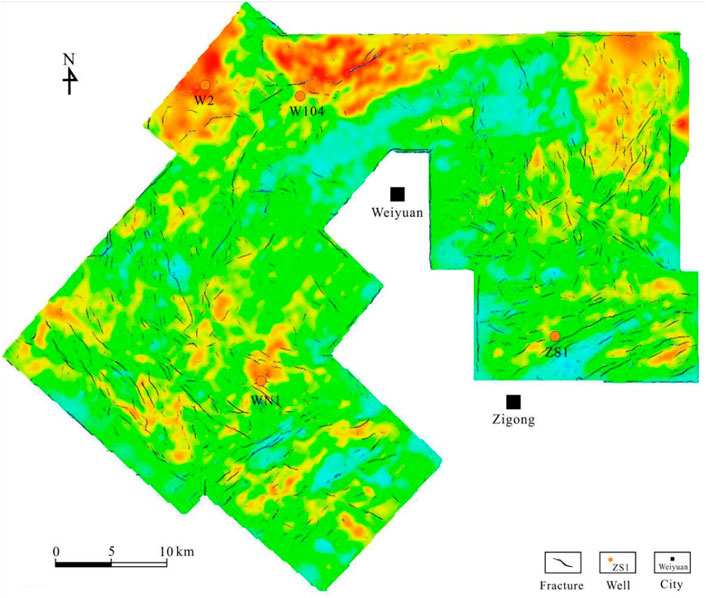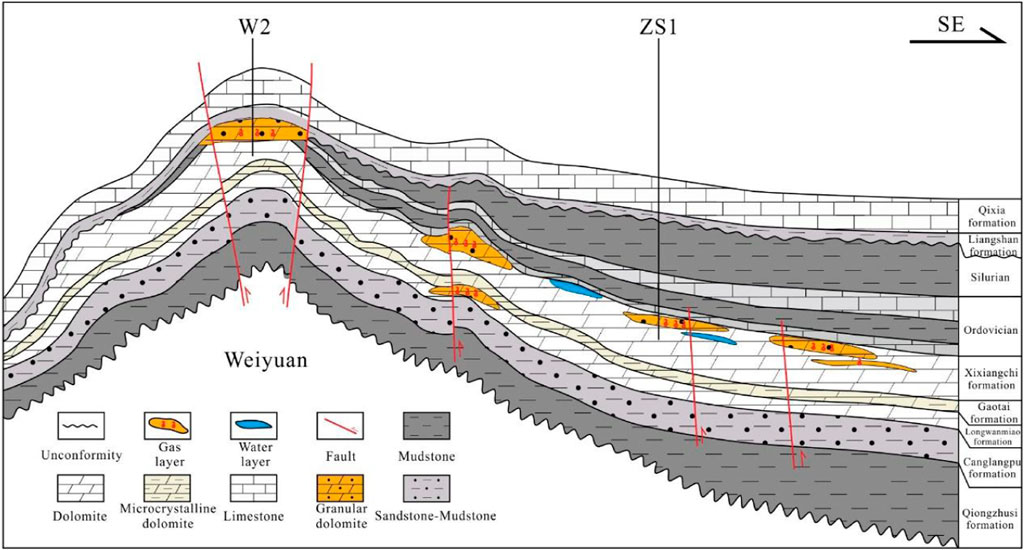- 1College of Energy, Chengdu University of Technology, Chengdu, China
- 2BGP Southwest Geophysical Research Institute, CNPC, Chengdu, China
- 3Exploration and Development Research Institute, PetroChina Southwest Oil and Gas Field Company, Chengdu, China
The Upper Cambrian Xixiangchi Formation in the Southern Sichuan Basin, China, has favorable hydrocarbon accumulation conditions. The accumulation factors and enrichment conditions of this formation were key considerations in this study. By analyzing core, thin section, seismic, and geochemical data, the research shows that there are many sets of granular and crystalline dolomite reservoirs in the Xixiangchi Formation vertically, with thin thickness of single-reservoir. During the transformation of karst and tectonism, dissolution pores and fractures developed to form an ideal reservoir space. The reservoir of the Xixiangchi Formation is connected to the Lower Cambrian source rock through a fault system. The high-energy shoal facies of the Xixiangchi Formation are located on the oil and gas migration path, providing an appropriate reservoir space for forming the source reservoir configuration relationship between the lower generation and upper reservoir. The key factors affecting hydrocarbon accumulation in the Xixiangchi Formation are sufficient oil and gas supply, development of inherited paleo-uplift, effective transportation system, and favorable reservoir-forming combination. The inherited paleo-uplift controls the distribution of gas reservoirs. Owing to the short migration distance of oil and gas, hydrocarbon is found near source hydrocarbon accumulation, and the paleo-uplift slope area should be targeted for exploration in future studies.
Introduction
Many dolomite oil and gas reservoirs have been found worldwide, mainly in North America, Asia, and Europe, and a few in Africa and South America (Saller and Henderson, 1998; Dutton et al., 2005; Ma et al., 2011; Manche and Kaczmarek, 2019). Oil production stems chiefly from the Late Cretaceous and Late Permian, gas production from the Late Jurassic and Early Permian, and condensate gas production from the Late Triassic to Late Jurassic and Late Devonian (Ma et al., 2011). Recently, dolomite gas fields have also been found in the ancient strata of the Early Cambrian (Du et al., 2014; Lin et al., 2020) and Neoproterozoic sediments (Wei et al., 2015; Xu, 2017), which demonstrates the exploration potential of deep, ancient dolomite gas fields. The geological conditions present in the Sichuan basin from the Ediacaran to the Cambrian allowed for the formation of large-scale natural gas fields. The space-time effective configuration of large ancient source rocks, ancient carbonate reservoirs, long-term inherited large-scale paleo-uplift, and crude oil cracking in ancient reservoirs led to the accumulation of natural gas (Wei et al., 2008; Du et al., 2014; Xu et al., 2014; Yang et al., 2021). In the past decades of exploration, the Xixiangchi formation gas field was found only in Weiyuan area, with 21 industrial gas wells and proven reserve of 85 × 108 m3 (Lin et al., 2017; Li et al., 2020). In recent years, commercial gas flow was obtained from well MX 23 and well GS 16 in the Xixiangchi Formation of the Moxi area, indicating that the prospect of finding natural gas in the Xixiangchi Formation is broad, providing a backup exploration field in the Sichuan Basin, China (Li et al., 2020; Lin et al., 2020).
Current research on the Xixiangchi Formation has focused on the central area of the Sichuan Basin, and the research content mainly involves sequence stratigraphy (Zhao, 2015; Li et al., 2017; Liu et al., 2018; Li et al., 2020; Lin et al., 2020; Jia et al., 2021), lithofacies paleogeography (Liu et al., 2011; Jiang et al., 2016; Shi et al., 2020). and reservoir characteristics (Feng et al., 2001; Shen et al., 2007; He et al., 2011; Zhang et al., 2011; Li et al., 2019; Yang et al., 2019a; Su et al., 2020). Although the success of Well MX 23 and Well GS 16 has improved our confidence in the exploration of Xixiangchi Formation, the complexity of hydrocarbon accumulation in Xixiangchi Formation is the main difficulty we face. Based on this, this paper, according to outcrop data, core observations, thin section identifications, and experimental analysis, on the analysis of hydrocarbon accumulation conditions of Xixiangchi Formation in the southern Sichuan Basin, combined with drilling exploration results, discusses the key factors affecting hydrocarbon accumulation in ancient dolomite gas reservoirs, defines the favorable exploration direction, and hopes to improve the drilling success rate in the exploration process.
Geological setting
The Sichuan Basin is a superimposed basin formed on the Yangtze Craton (Figure 1A). The sedimentary cover consists of Ediacaran to Middle Triassic marine strata and Late Triassic to Cenozoic terrestrial strata (Shen et al., 2007; He et al., 2011; Liu et al., 2011; Zhang et al., 2011; Li et al., 2019; Su et al., 2020; Li et al., 2022). In the late Ediacaran, The Tongwan movement raised the Ediacaran strata to the surface, and the Dengying Formation experienced large-scale supergene karstification (Du et al., 2014; Xu et al., 2014; Yang et al., 2021). In Cambrian, Sichuan Basin was a period of stable cratonic basin development, showing a sedimentary pattern of high in the west and low in the east (He et al., 2011). In the late Cambrian Xixiangchi period, evaporative salt basin was developed in the central part of Sichuan Basin, and a rapid large-scale transgression occurred in its early sedimentary period, making Sichuan basin covered by a large range of restricted platform facies. The closed environment of evaporation and concentration in the platform evolved into an open - semi-open environment, and the Chongqing - Yibin area changed from evaporative salt basin to intra-platform depression sedimentation (Figure 1) (Yang et al., 2019a; Gu et al., 2020). The water energy on both sides of the platform depression was relatively high, and high energy granular beach belts were developed. The Xixiangchi period was dominated by salty seawater sedimentary environment and warm or hot subtropical climate, and the ancient seawater temperature was mainly 19°C–25°C (Li et al., 2019). The Ordovician began to water-transgress, and the Sichuan Basin was dominated by shelf-to-basin facies. At the end of the Silurian, the Late Caledonian movement came the uplift and denudation of the Leshan-Longnusi paleo-uplift, resulting in an angular unconformity between the Cambrian and Permian strata in the southwestern Sichuan Basin (Su et al., 2020; Luo et al., 2022). The Xixiangchi Formation in the Southwestern Sichuan Basin is denuded (Gu et al., 2020; Li et al., 2020) (Figure 1B).
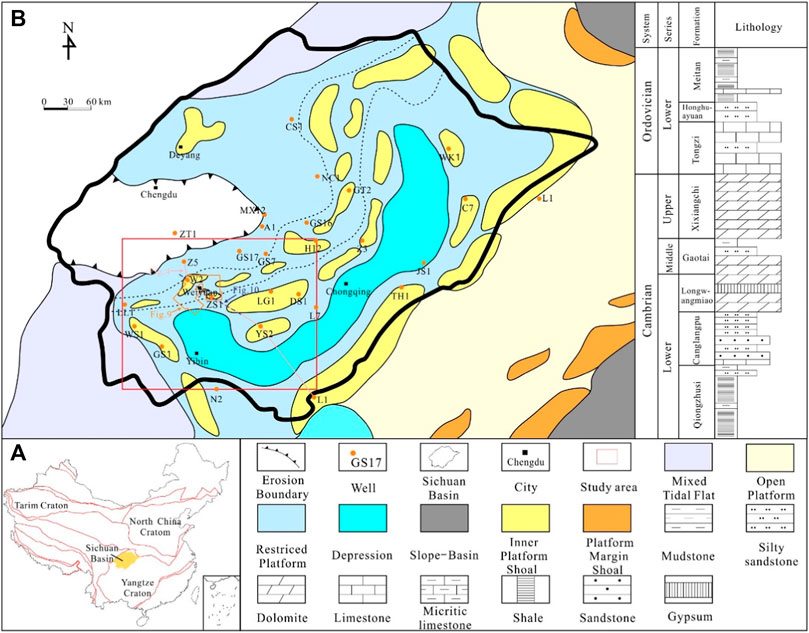
FIGURE 1. Comprehensive geological map of the study area. (A) Sketch map of tectonic units in China and the location of study area [modified form Luo et al.(2016)]; and (B) Lithofacies and paleogeography map of the Cambrian Xixiangchi period in Sichuan Basin [modified form Gu et al.(2020)].
Granular rocks in the Xixiangchi Formation are mostly in the inverse grain sequence, with a finer bottom and coarser top, representing carbonate platform shoal deposits of an upward shallowing epeiric sea. Under the control of paleomorphology and sea level fluctuation (Gu et al., 2020; Jia et al., 2021), the shoals at the platform margin were large in scale and thickness, but the shoals at the inner platform were small in scale, thin in thickness, and frequently migrate laterally (Zhao, 2015). After the dolomitization and dissolution transformation of the granular shoal reservoir of the Xixiangchi Formation (Shi et al., 2020), the reservoir spaces developed intergranular, intercrystalline, and dissolved pores (Jiang et al., 2016; Li et al., 2020). There is a strip of denudation zones in the West, wherein a weathering crust reservoir developed (Gu et al., 2020; Li et al., 2020). Supergene karstification (Xu et al., 2014) and penecontemporaneous karstification (Du et al., 2014) are key factors contributing to the formation of high-quality dolomite reservoirs. Multistage tectonic movement caused the Xixiangchi Formation to develop structural fractures, which connected the pore spaces and helped improve reservoir connectivity (Lin et al., 2017).
From West to East, the Xixiangchi Formation in the Sichuan Basin successively developed an evaporation platform, restricted platform, open platform, platform margin, slope, and basin. Owing to the influence of ancient land on the west side of the Sichuan Basin (Feng et al., 2001), the western part of the basin is characterized by mixed deposition of clastic and carbonate rocks, and the lithology is dominated by fine sandstone, sandy dolomite, and dolomite. From West to East, the terrigenous clastic content decreases gradually, and dolomitic flats dominated by argillaceous dolomite begin to appear. There is a NE-trending platform depression along Yibin to Chongqing, and the sediments there are composed mainly of fine crystalline dolomite. On both sides of the platform depression is the NE trending intra-platform granular shoal belt, and the lithology is sandy clastic dolomite, oolitic dolomite, and coarse crystalline dolomite. The hydrodynamic force at the platform margin was strong, and the scale of the granular shoal was larger than that of the intra platform. The Eastern side of the Sichuan Basin is a slope-to-basin environment, and its lithology is dominated by limestone and argillaceous limestone (Li et al., 2019; Gu et al., 2020; Jia et al., 2021) (Figure 1B).
Methods and methods
The samples used in the lithological identification and geochemical analysis were obtained from wells in the Southwestern Sichuan Basin (Figure 1). Approximately 219 samples were polished on both sides, and thin sections were impregnated with blue epoxy resin for pore observation. The thin section samples were polished to 0.03 mm. Before identification, thin sections were stained with a mixed solution of alizarin red and potassium ferricyanide and observed using a LEICA DMLP-217400 microscope in the State Key Laboratory of Petroleum Exploration and Development.
The samples were washed with toluene and methanol to remove hydrocarbon and salt precipitations, and then dried at 80°C for 48 h before measurement. Clean and dry samples were weighed first, then placed in a sealed container and evacuated up to a vacuum pressure of 0.001 psi. Therefore, the container was filled with an equal amount of NaCl brine and gradually pressurized for several hours until a fixed pressure of 2000 psi. Finally, the initial porosity was estimated based on the weight difference between dry and saturated samples, which was taken as the volume of brine injected into each core sample. At each selected stress step when the equilibrium based on defined criteria was reached, the expelled fluid volume at each stress loading was measured and then brine injected to the sample in order to calculate the brine permeability using Darcy model (steady-state method) (Rashid et al., 2017). The estimated porosity can be made to within ± 0.1 porosity unit using the apparatus and protocols at the State Key Laboratory of Petroleum Exploration and Development.
Use gas analyzer (MAT-271) and isotope mass spectrometer (Delta-V-Advantage) to analyze gas components and carbon isotopes respectively, the gas collected in the bottle is sealed with saturated salt water and injected into the gas injection port of the gas chromatograph with a syringe. The gas is brought into the chromatographic column by helium and divided into methane, ethane, propane, butane monomer components. Each monomer component is oxidized into carbon dioxide gas at high temperature after entering the oxidation furnace, and finally brought into the mass spectrometer for isotope testing (Li et al., 2022; Li, 2022; Zhang et al., 2022). The measurement accuracy is ±0.1‰, which is completed in the State Key Laboratory of Oil and Gas Reservoir Geology and Exploitation.
Geological conditions of hydrocarbon accumulation
The geological conditions necessary for the formation of carbonate gas reservoirs are manifested mainly in terms of hydrocarbon source conditions, reservoir characteristics, cap rock sealing efficiency, and reservoir forming time-space allocation.
High-quality source rocks developed underneath
The source rock of the Lower Cambrian Qiongzhusi Formation is the most important source rock in the Sichuan Basin, providing hydrocarbon for the overlying Xixiangchi Formation (Shi et al., 2018). The type of organic matter in the source rocks of the Qiongzhusi Formation is type I kerogen (Xiong et al., 2021), and the total organic carbon (TOC) content is between 0.5% and 4.0%, with an average of 2.0%. The degree of thermal maturity of source rocks was high, and the pyrobitumen reflectance values were greater than 2.5%. The Qiongzhusi source rocks have thermal maturities that range from postmature to overmature, and the generation capability of the source rock has been high in the past, resulting in a high amount of oil. Gas is produced primarily via oil and kerogen cracking (Shi et al., 2018).
The high-quality Lower Cambrian source rocks were mainly deposited in the intracratonic sag (Figure 2). The thickness of the black shale in the Qiongzhusi Formation is 200–300 m in the Weiyuan area. The thickness of the carbonaceous shale of the Qiongzhusi Formation in well GS 17 was more than 350 m. The Qiongzhusi Formation in well GS seven on the east side of the intracratonic sag was incomplete, missing the lower members of the Qiongzhusi Formation, and the thickness of the mudstone was only 100 m. The source rocks of the Qiongzhusi Formation are distributed in a NNE direction on the plane, approximately 500 km long from North to South and 35–110 km wide from East to West. The source rocks in the Southern Sichuan Basin are characterized by extreme thickness, wide distribution, high TOC content, high degree of thermal maturity, and high hydrocarbon generation capacity. Therefore, the southern Sichuan Basin is regarded as a favorable target for future gas exploration.
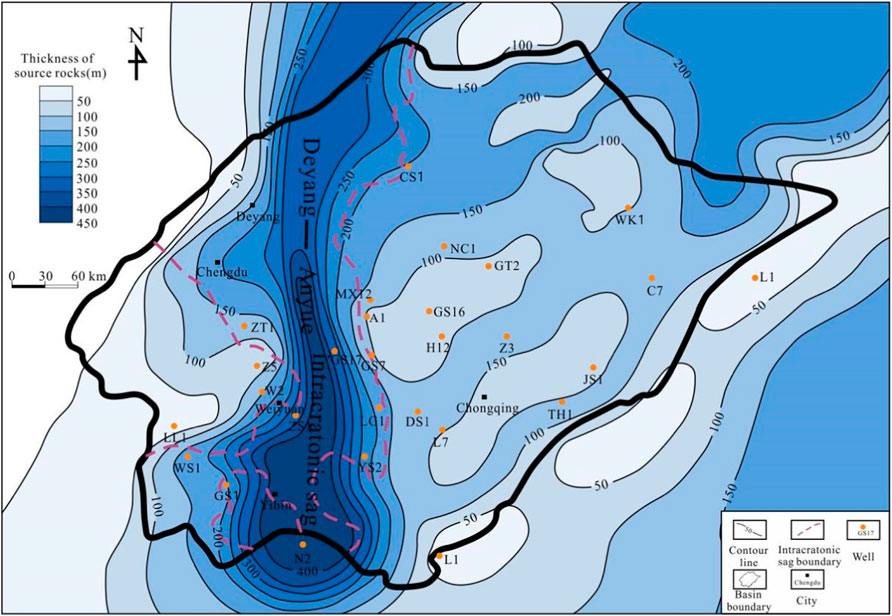
FIGURE 2. Thickness distribution of Lower Cambrian source rock in Sichuan Basin [modified from Yang et al. (2019a)].
Reservoir characteristics of Xixiangchi formation
The analysis of drilling cores and field outcrop data shows that the Xixiangchi Formation reservoir lithology is dominated by granular and crystalline dolomite (Figures 3A–I), which belong to the intraplatform shoal environment. Many dissolution holes and fractures developed in the reservoir (Figures 3E–J), which were evidently modified by karstification and tectonism (Lin et al., 2017; Tian et al., 2019; Li et al., 2020; Lin et al., 2020). According to drilling and outcrop data, the thickness of dolomite in the Xixiangchi Formation is 70–340 m, which can be divided into three stages of fourth-order sequences (Gu et al., 2020; Ning et al., 2020; Shi et al., 2020). The reservoir developed in the middle and upper parts of the highstand systems tract (HST). The thickness of a single set of reservoirs is approximately 2–5 m; the cumulative thickness of the reservoir is typically less than 20 m, and the horizontal distribution distance of the reservoir is short (Figure 4). Sedimentary facies controled the distribution of granular beach, which was developed in shallow water area of high landform. The granular beach was exposed due to the sea level decline in highstand systems tract stage, and the granular beach in the high part of the ancient landform was exposed in a large area for a long time. The penecontemporaneous meteoric freshwater dissolution caused by the sea level decline form a large number of dissolution holes, which was conducive to improving the physical properties of the reservoir (Figures 3E,H,I). In the late Caledonian movement, the southwestern part of Sichuan Basin was aggressively uplifted, resulting in the formation of the Leshan-Longnusi paleo-uplift (Su et al., 2020). After approximately 120 Ma denudation from Caledonian to Hercynian (Pang et al., 2007), the Xixiangchi Formation in the southwestern Sichuan Basin was denuded (He et al., 2011; Liu et al., 2011). Epigenic karstification occurred at the top of the Xixiangchi Formation in the area near the denudation line (Gu et al., 2020; Li et al., 2020). Owing to strong dissolution, intercrystalline solution pores developed in the rocks at the top of the Xixiangchi Formation near the denudation line (Figure 3I). The epigenic karst zone rises around the Leshan-Longnusi paleo-uplift and is distributed in a “strip-like” belt 20–50 km wide (Li et al., 2020). Owing to tectonic movement after deposition, multiple vertical fractures can be identified from the image logging data obtained by drilling in the Weiyuan area (Figure 3J). The development of fractures can improve the permeability and connectivity of reservoirs.

FIGURE 3. Reservoir space types of Xixiangchi Formation in the Southern Sichuan Basin. (A) Well WH1, Xixiangchi Formation, 2,209 m, medium granular dolomite; (B) Well N2, Xixiangchi Formation, 2,100 m, medium to coarse granular dolomite; (C) Well WH1, Xixiangchi Formation, 2,232 m, medium granular dolomite; (D) Well DS1, Xixiangchi Formation, 5,332.3 m, fine crystalline dolomite, developed intermediate dissolved pores; (E) Well H12, Xixiangchi Formation, 4,848.6 m, fine crystalline dolomite with residual grain texture, intercrystalline dissolved pores developed; (F) Well L1, Xixiangchi Formation, 2,105 m, coarse crystalline dolomite, intercrystalline dissolved pores developed and filled with bitumen; (G) Well LL1, Xixiangchi Formation, 2,246.50 m, coarse crystalline dolomite, intercrystalline dissolved pores developed and filled with bitumen; (H) Well LG1, Xixiangchi Formation, 4,624.38 m, fine crystalline dolomite with residual grain texture, intercrystalline dissolved pores developed and filled with bitumen; (I) Well WS1, Xixiangchi Formation, 2,254 m, granular dolomite, with intergranular dissolved pores and vugs; (J) Well H12, Xixiangchi Formation, 4,620–4,623 m image logging feature map, developed pinhole dissolution holes and vertical seams.
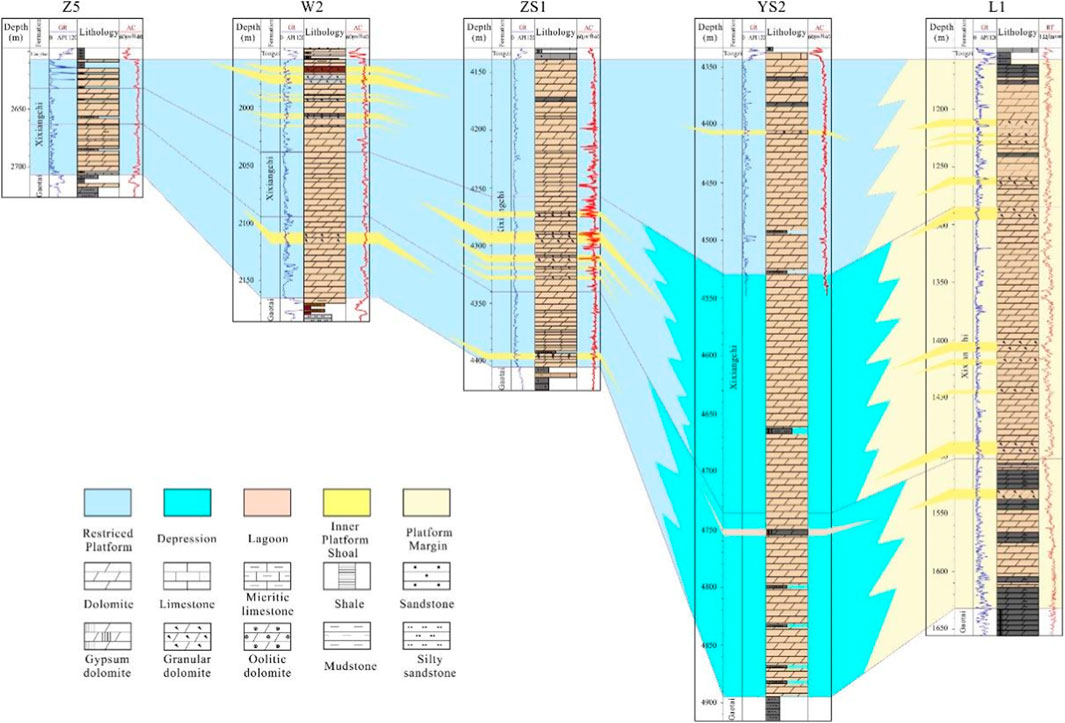
FIGURE 4. The stratigraphic correlation diagram and reservoir distribution of Xixiangchi Formation from well Z5 to well L1.
The thickness of a single set of reservoirs is approximately 2–5 m, and the lateral extension distance of the reservoir is short. The reservoir developed in the middle and upper parts of the highstand systems tract and paleogeomorphic highlands.
Regional stable cap rock
The direct cap rock above the Xixiangchi Formation in the Southern Sichuan Basin is an Ordovician mudstone. The Lower Ordovician Tongzi Formation and the Upper Cambrian Xixiangchi Formation are in parallel unconformity-conformity contact (Li et al., 2020). The Tongzi Formation in the southern Sichuan Basin is dominated by siltstones, limestones, and thin mudstones. The sedimentary paleogeography of the Lower Ordovician Honghuayuan Formation was similar to that of the Tongzi Formation. Its lithology is dominated by siltstone, and the limestone and mudstone contents are reduced. The Lower Ordovician Meitan Formation and the Upper Ordovician Wufeng Formation are characterized by deep-water sedimentary formations dominated by black shale deposits (Li et al., 2015). The Lower Ordovician Meitan Formation in southern Sichuan was a shelf deposit. The lithology is mainly black mudstone with a thickness of between 30 and 120 m (Figure 5); The Upper Ordovician Wufeng Formation is a deep-water shelf deposit, and the lithology is mainly black carbonaceous shale, siliceous shale, and graptolite shale intercalated with thin-layer radiolarians Siliceous rock; its deposition thickness is less than 20 m. The Meitan Formation has a large stratum thickness, fine lithological grain size, undeveloped pores, and good sealing ability.
The analysis results of the formation water in the Xixiangchi Formation of seven gas wells in the Weiyuan Gas Field show that the mass concentration of Cl− was between 42,795 and 64,261 ppm, the mass concentration of SO42- was 114–775 ppm, and the total water formation was between 42,795 and 64,261 ppm. The degree of chemical conversion is between 69.30 and 100.89 g/L, and the water type is calcium chloride, reflecting the better preservation conditions of Xixiangchi gas reservoirs and demonstrating that the Xixiangchi gas reservoirs have strong cap rock sealing ability.
The cap rock lithology of Xixiangchi formation is mainly mudstone, and the mudstone is stably distributed, which can be used as the regional cap rock of Xixiangchi formation.
Gas reservoir characteristics of Weiyuan gas field
The structure of the Xixiangchi Formation in the Weiyuan Gas Field is a dome-shaped anticline that was shaped during the Himalayan period (Mei, 2015). According to the porosity analysis statistics of 219 samples from the Xixiangchi Formation reservoirs in the Southern Sichuan Basin (Figure 6A), the reservoir porosity was between 0.16% and 5.64%, with an average value of 2.21%, and the number of samples with porosity greater than 2% accounted for 60.0% of the total number of samples. According to the permeability analysis statistics of 198 samples (Figure 6B), the reservoir permeability is between 4.96 × 10−6 and 419 mD, with an average value of 0.098 mD, and the number of samples with permeability greater than 0.01 mD accounted for 24.7% of the total number of samples. Reservoirs are typically characterized by low porosity and ultralow permeability. The fractures in the core can be divided into two types: high-angle fractures with inclinations of 70°–85° and horizontal fractures with inclinations of less than 5° (Figure 3J). Owing to strong heterogeneity of the dolomite reservoirs, there are multiple gas reservoirs in the Xixiangchi Formation of the Weiyuan Gas Field and their spatial distribution is limited by tight dolomite. Affected by later tectonic movement, the distribution of oil and gas was controlled by both structure and lithology. Structural traps form in the high part of the anticline, and structural-lithological composite traps develop mostly in the structural slope area.
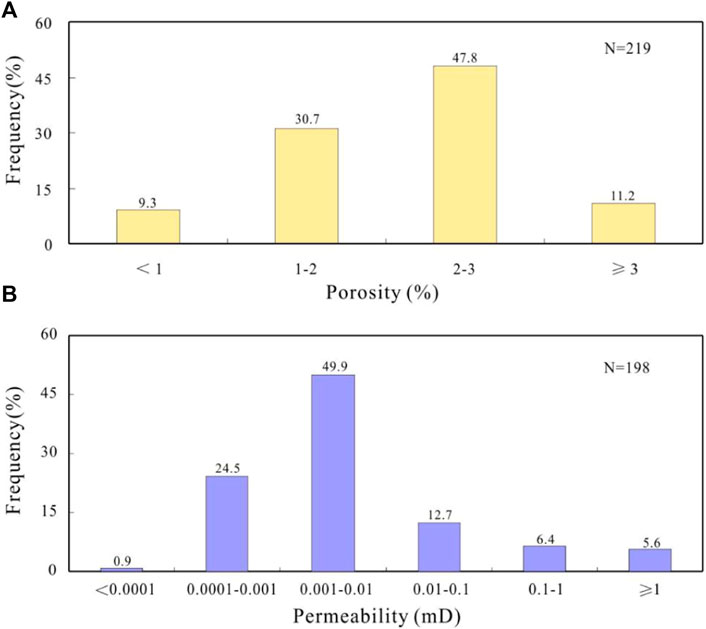
FIGURE 6. Reservoir physical property distribution map of Xixiangchi Formation in southern Sichuan basin. (A) Reservoir porosity distribution map of Xixiangchi Formation; (B) Reservoir permeability distribution map of Xixiangchi Formation.
Discussion
Sufficient oil and gas supply is the basis for hydrocarbon accumulation
The distribution of Lower Cambrian high-quality source rocks in the Sichuan Basin is controlled by the distribution of the Deyang–Anyue intracratonic sag. Presently, the Anyue super large gas field has been discovered in the eastern margin of the intracratonic sag (the reservoirs are mainly Dengying and Longwangmiao Formations), and the Weiyuan Gas Field developed on the west side of the intracratonic sag (the reservoirs are mainly Dengying and Xixiangchi Formations). The source rock in the intracratonic sag is a product of an anoxic environment and has high paleo productivity (Yang et al., 2021). The CH4 content of the Xixiangchi Formation in Weiyuan Gas Field was between 85.4% and 89.4% (Figure 7A), the C2H6 content was less than 0.1%, and the dryness coefficient of gas was greater than 99% (Figure 7B).
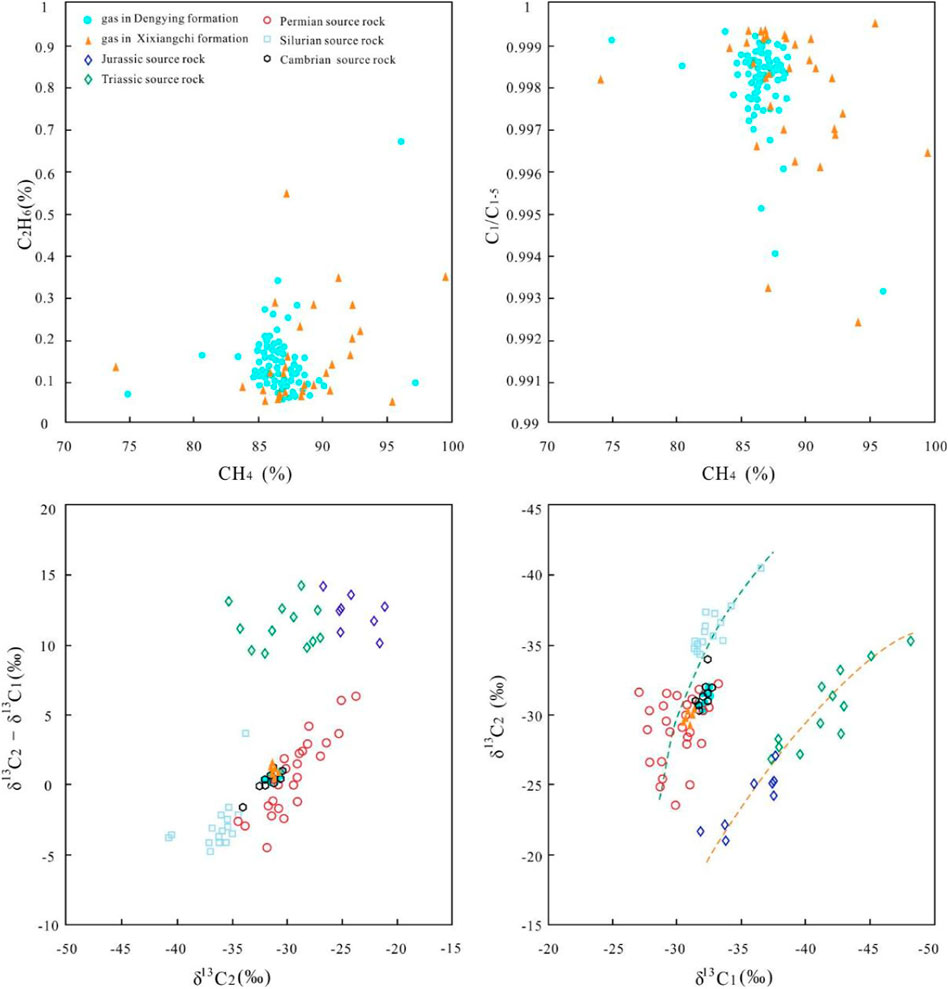
FIGURE 7. Characteristic diagram of natural gas component. (A) The relationship between methane content and ethane content; (B) The relationship between methane content and drying coefficient; (C) Carbon isotopic relationship between ethane and (δ13C2-δ13C1); (D) Carbon isotopic relationship between methane and ethane.
The hydrocarbon component characteristics of gas (Figures 7C,D) in the Dengying and Xixiangchi Formations of the Weiyuan Gas Field are similar. The gas in the Dengying and Xixiangchi Formation reservoirs mainly originates from the cracked gas of ancient oil reservoirs and the gas generated from the source rocks of the Qiongzhusi Formation (Dai, 2003; Wei et al., 2015; Xu, 2017). Therefore, the gas of Xixiangchi Formation comes from the pyrolysis of crude oil and the cracking of source rock of Qiongzhusi Formation. There is a thick-bedded high-quality source rock of the Qiongzhusi Formation in the southern Sichuan Basin with a small oil and gas migration distance and sufficient oil and gas supply, which is the material basis for hydrocarbon accumulation in the Xixiangchi Formation reservoir.
Taking GS17 Well as an example to conduct a one-dimensional simulation of the Sichuan Basin, Figure 8 shows that the source rocks of the Qiongzhusi Formation entered the oil-generation threshold in the Late Ordovician and began to discharge hydrocarbons. In the Late Silurian, the Caledonian movement led to the overall uplift of the Sichuan Basin, stagnation of sedimentation, strong denudation of the surface, temperature decrease of the source rocks, and sharp weakening of hydrocarbon generation. From the beginning of the Early Permian, the Sichuan Basin began a large-scale transgression, and the entire basin was submerged in water.
With increasing burial depth, the source rocks of the Qiongzhusi Formation entered the hydrocarbon generation peak again from the Late Permian to Late Triassic. Subsequently, from Late Triassic to Middle Jurassic, the value of vitrinite reflectivity (Ro max %) reached 1.3% and began to enter the stage of generating wet gas. Since the Middle Jurassic, the Ro value has reached 2.0%, and since then, it has entered the stage of generating dry gas.
The source rocks of the Qiongzhusi Formation began to discharge hydrocarbons in the Late Ordovician, then reached the oil generation peak from the Late Permian to Late Triassic. Subsequently, began to generate wet gas from Late Triassic to Middle Jurassic. From the Middle Jurassic to present, it is the stage of generating dry gas.
Inherited paleo-uplift controls hydrocarbon accumulation
The study of sedimentary-tectonic evolution history of the Early Paleozoic Sichuan Basin indicates that the Leshan-Longnusi paleo-uplift had taken shape by the end of the Early Cambrian (Su et al., 2015). The deposition of the Xixiangchi Formation in the southern Sichuan area is controlled by Leshan-Longnusi paleo-uplift and its paleogeomorphology, which is dominated by relatively high mixed tidal flat deposition in the Northern part. The water body gradually deepened to the South and transitioned to a clear water carbonate platform deposition (Figure 1B). The greater the thickness of the Xixiangchi Formation, the lower the paleogeomorphology at that time. Water depth controlled the change in the sedimentary facies. The Leshan-Longnusi paleo-uplift continued to rise during the Cambrian-Silurian (Mei, 2015). At the end of the Silurian, the Caledonian Movement caused the Leshan-Longnusi paleo-uplift to undergo significant indigenous structural deformation. The southwestern part of Sichuan Basin was the core of the Leshan-Longnusi paleo-uplift, and its structural axis was the Ya’an-Ziyang-Suining area, resulting in the denudation and leveling of the Silurian-Cambrian strata in the structural axis. During the Hercynian and Indosinian periods, the paleotectonic pattern maintained the shape of the late Caledonian period, and the Southern Sichuan Basin continued to be located between the high part of the paleo-uplift and the Southern slope of the paleo-uplift. During the Indosinian period, Sichuan Basin entered the development stage of foreland basin, the Eastern part was uplifted, the Western part was subsiding, and the Triassic strata became significantly thinner from West to East, which made the Leshan-Longnusi paleo-uplift tectonic axis move to Southeast. The Himalayan Movement greatly uplifted the Weiyuan structure and became a new tectonic highpoint in the Southern Sichuan Basin.
With the history of tectonic evolution in Southern Sichuan Basin, and through the analysis of the thermal evolution history of source rock of the Qiongzhusi Formation (Figure 8), it is evident that the source rock of the Qiongzhusi Formation entered the hydrocarbon generation window before the formation of the Leshan-Longnusi paleo-uplift in the late Caledonian. Ancient oil reservoirs may be formed on the slope and high part of the paleo-uplift. During the Hercynian-Indosinian period, the tectonic framework of the Leshan-Longnusi paleo-uplift was stable, and the source rock of Qiongzhusi Formation began to generate hydrocarbon, on a large scale, for the second time. Large-scale ancient oil reservoirs were formed in different types of traps in the Ziyang, Anyue, Weiyuan, and Moxi-Gaoshiti areas (both sides of the Deyang-Anyue rift trough), which was specifically manifested as a large amount of residual asphalt in the reservoir pores of the Xianxixiangchi Formation, which is the product of the thermal cracking of ancient oil reservoirs (Lin et al., 2017; Li et al., 2020) (Figure 3H).
Since the Yanshanian period, the source rock of Qiongzhusi Formation had entered the high-temperature gas generation stage with a Ro value greater than 2.0%, and the ancient oil reservoirs of the Dengying, Longwangmiao, and Xixiangchi Formations began to crack into gas (Xu et al., 2014). During the Himalayan period, owing to the continuous compression of the Qinghai-Tibet Plateau to the Sichuan Basin, the eastern margin of the Qinghai-Tibet Plateau collided with the western margin of the Sichuan Basin, forming the Longmenshan orogenic belt (He et al., 2011; Yang et al., 2019b). The tectonic stress continued to transfer to the interior of the basin, resulting in the Weiyuan anticline becoming the highest structural point of the Leshan-Longnusi paleo-uplift today. Concurrently, the pyrolysis gas of the ancient oil reservoirs and the high-temperature pyrolysis gas of the Qiongzhusi Formation source rock accumulated near the structural high point and slope of Weiyuan, indicating the complexity of the methane carbon isotope (Xu et al., 2014).
The hydrocarbon fluid migrates from the high potential energy area to the low potential energy area (Allan, 1989). The elevated position around the hydrocarbon depression was the dominant migration direction of the hydrocarbon fluid. The high-energy particle beach facies located in the oil and gas migration path provides a suitable reservoir space for oil and gas accumulation. The oil and gas accumulation of the Xixiangchi Formation in the Southern Sichuan area is controlled by sedimentation and structure. Granular dolomite and crystalline dolomite developed in the high-energy facies belt of Xixiangchi Formation located in the high part and slope area of the paleo structure, becoming the most favorable areas for oil and gas accumulation after the transformation of quasi-syngenetic-epigenetic karstification (Lin et al., 2015; Li et al., 2020; Shi et al., 2020). The inherited paleo-uplift provides favorable conditions for oil and gas accumulation and controls the distribution range of oil and gas reservoirs. The accumulation of oil and gas is closely related to the sediment-tectonic evolution of the Sichuan Basin. Many oil and gas reservoirs formed around the Leshan-Longnusi paleo-uplift.
Effective transportation system is a crucial factor in hydrocarbon accumulation
The oil and gas resources in the reservoir pores are movable fluids. The migration and accumulation of oil and gas are controlled by changes in the fluid potential of spaces. The gradient zone and low potential energy area of the fluid potential are the pointing zones for oil and gas migration. Oil and gas migrate from the high-potential-energy area to the low-potential-energy area and accumulate in the low-potential-energy area with suitable preservation conditions (Allan, 1989). However, the existence of a fault system may affect the spatial distribution characteristics of fluid potential. Owing to the fractures formed by tectonic movement, several fractures developed in the rock stratum. In the fault system, owing to a decrease in fluid potential energy, the fluid migrates from the high-potential-energy area to the fault system area, and oil and gas fill the trap along the fracture (Guo et al., 1996; Chen, 2011). Because the fault activity is periodic, the fault system can not only be a favorable channel for vertical large-scale oil and gas migration and accumulation, but also be a crucial factor for the destruction of oil and gas reserve. A fault system is a principal factor in controlling the migration, accumulation, and loss of oil and gas.
Based on the analysis of contiguous 3D seismic data and the distribution position of drilling reservoirs in the Weiyuan area, the seismic coaxial energy was weakened, and the low-frequency signal was enhanced when the reservoirs of the Xixiangchi Formation were developed. Therefore, the amplitude and frequency attribute data can be fused to obtain a new attribute distribution map of the Xixiangchi Formation, which can be used to qualitatively describe the distribution characteristics of the reservoir in the plane of the Xixiangchi Formation (Figure 9). The yellow to red areas represent the reservoir development areas, and the green to blue areas represent the undeveloped areas. Simultaneously, the ant property can clearly and effectively depict the spatial distribution of the formation fault system. Through the analysis of ant properties at the bottom boundary of the Xixiangchi Formation in the Weiyuan area, is evident that several fractures developed in the Xixiangchi Formation in the Weiyuan area, and the directions of the fractures are controlled by ground stress, mainly in the NE–SW, near S–N, and NW–SE directions. Many developed fractures are effective transportation systems and are also necessary conditions for oil and gas to migrate from source areas to traps.
The yellow to red areas represent the reservoir development areas, the green to blue areas represent the undeveloped areas, and the dark areas represent fractures.
Favorable reservoir forming combination is the key factor for hydrocarbon accumulation
Under the transformation of karstification and tectonization, dissolution pores and cracks developed in the granular and grain dolomite of the Xixiangchi Formation in the southern Sichuan Basin. The reservoirs were superimposed vertically, but the thickness of a single reservoir was low. The gas source of the Xixiangchi Formation originates from the source rocks of the underlying Qiongzhusi and Maidiping Formations and the cracked gas formed by the cracking of ancient oil reservoirs. During the deposition of the overlying Tongzi, Honghuayuan, and Meitan Formations, the water energy was low, and the sediment grain size was fine. In particular, the pores of the mudstone caprock in the Meitan Formation were not developed, and the sealing ability was strong. This thick mudstone is a regional caprock (Li et al., 2015).
The high-quality reservoirs developed in the restricted platform granular beach of the Xixiangchi Formation in the southern Sichuan Basin are distributed mainly in the Southern part of the Deyang-Anyue rift trough, which is a thick layer area of high-quality source rocks of the Lower Cambrian. According to the analysis results of hydrocarbon generation and evolutionary history of the Qiongzhusi Formation source rock (Figure 8), the Late Caledonian, Indosinian, and Yanshanian periods were the peak periods of hydrocarbon generation and expulsion. The high-quality reservoirs in the Xixiangchi Formation are connected to the Lower Cambrian source rock in the rift trough through the fault system, forming the source-reservoir configuration relationship of the lower generation and upper storage. Short-distance migration of oil and gas is beneficial for the formation of oil and gas reservoirs. The high-quality reservoir had the characteristics of near-source accumulation (Figure 10).
The dolomite reservoir of the grain beach in the Xixiangchi Formation is in the paleo-uplift slope area at an elevated position around the hydrocarbon generation depression. The high-quality reservoirs in the Xixiangchi Formation are connected to the Lower Cambrian source rock in the rift trough through the fault system, forming a source-reservoir configuration relationship between the lower generation and upper storage.
Because of the small single-layer thickness and small lateral extension distance of the reservoirs, the reservoir is quite heterogeneous. Oil and gas accumulation is controlled by lithological changes under the structural background. In addition to the structural traps in the Weiyuan area, the trap types in the Southern Sichuan area are mainly structural-lithologic traps. Late Yanshanian-Himalayan tectonic activity was strong, resulting in strong uplift of the basin margin and the formation of Weiyuan and Luzhou-Kaijiang paleo-uplifts and high-steep structural belt in Eastern Sichuan. According to the analysis results of the formation water of the Xixiangchi Formation in southern Sichuan Basin, the formation water type is calcium chloride, which indicates that the gas reservoirs of the Xixiangchi Formation have suitable preservation conditions.
From the analysis of the main controlling factors of hydrocarbon accumulation, the regional distribution of high-quality source rocks, near-source high-quality reservoirs, and inherited structural uplift are the most favorable areas for the distribution of oil and gas fields. Combined with the source rock, reservoirs, caprock, structures, faults, preservation conditions, and other factors, it is evident that the oil and gas sources of the Xixiangchi Formation in the Southern Sichuan area are sufficient. High-quality fractured vuggy reservoirs developed, and the sealing ability of the upper cover layer was strong. Tectonism plays a positive role in the formation of traps, and the fault system communicates with the source and storage space. The fractures improved the physical properties of the reservoirs, and the preservation conditions were good in the later period. Therefore, the area where shoal reservoirs and fractures developed in the ancient uplift slope is the next key exploration area in the Xixiangchi Formation.
Conclusion
1) The thick-bedded source rock of the Qiongzhusi Formation entered the oil-generation threshold during the Late Ordovician, when it began to discharge hydrocarbons. In the Late Silurian, the hydrocarbon generation effect weakened significantly. From the Early Permian to the Late Triassic, the source rock entered the peak of hydrocarbon generation again. Since the Middle Jurassic, the source rock has entered the stage of large-scale dry gas generation, resulting in the overlying Xixiangchi Formation dolomite reservoir having a sufficient gas supply.
2) The dolomite reservoir of the Xixiangchi Formation developed many dissolved pores and fractures, which were affected by karst and structural transformation. The underlying source rock of the Qiongzhusi Formation provides sufficient gas. Under the high sealing performance of the Upper Ordovician strata, the Xixiangchi Formation had ideal reservoir-forming conditions.
3) Hydrocarbon accumulation in the Xixiangchi Formation is closely related to the sedimentary-tectonic evolution of the Sichuan Basin. The inherited paleo-uplift provides favorable conditions for hydrocarbon accumulation and controls the distribution range of gas reservoirs. The dolomite reservoir of the grain beach in the Xixiangchi Formation is in the paleo-uplift slope area at an elevated position around the hydrocarbon generation depression. The fault system connects the reservoirs and source rock, forming a source–reservoir configuration relationship between the lower generation and upper storage. Short-distance migration of oil and gas is beneficial for the formation of oil and gas reservoirs. Therefore, further exploration should focus on the paleo-uplift slope.
Data availability statement
The data analyzed in this study is subject to the following licenses/restrictions: The original contributions presented in the study are included in the article/Supplementary Material, further inquiries can be directed to the corresponding author. Requests to access these datasets should be directed to huxiuquan15@cdut.edu.cn.
Author contributions
XH: conceptualization, funding acquisition, methodology, Writing-original draft. WL: Conceptualization, methodology. DZ: Formal analysis, methodology, Writing-original draft. WW: Formal analysis, methodology, Writing-review and editing. CY: Formal analysis, investigation. JL: Investigation, writing—review, and editing.
Funding
This study was financially supported by the National Natural Science Foundation of China (Grant No. 42172175).
Acknowledgments
We would like to thank PetroChina Southwest Oil and Gas Field Company for providing the data and allowing the publication of this article.
Conflict of interest
The author WW was employed by PetroChina Southwest Oil and Gas Field Company.
The remaining authors declare that the research was conducted in the absence of any commercial or financial relationships that could be construed as a potential conflict of interest.
Publisher’s note
All claims expressed in this article are solely those of the authors and do not necessarily represent those of their affiliated organizations, or those of the publisher, the editors and the reviewers. Any product that may be evaluated in this article, or claim that may be made by its manufacturer, is not guaranteed or endorsed by the publisher.
References
Allan, U. S. (1989). Model for hydrocarbon migration and entrapment within faulted structures. Am. Assoc. Pet. Geol. Bull. 73 (7), 803–811. doi:10.1306/44b4a271-170a-11d7-8645000102c1865d
Chen, M. M. (2011). The relationship between wubao fault zone in gaoyou depression and hydrocarbon A ccumulation. Beijing, China: China University of Petroleum. [in Chinese].
Dai, J. X. (2003). Pool-forming periods and gas Sources of Weiyuan gasfield. Petroleum Geol. Exp. 25 (5), 473–480. [in Chinese]. doi:10.3969/j.issn.1001-6112.2003.05.010
Du, J. H., Zhou, C. N., Xu, C. C., He, H. Q., Shen, P., Yang, Y. M., et al. (2014). Theoretical and technical innovations in strategic discovery of a giant gas field in Cambrian Longwangmiao Formation of central Sichuan paleouplift, Sichuan Basin. Petroleum Explor. Dev. 41 (3), 294–305. doi:10.1016/s1876-3804(14)60035-5
Dutton, S. P., Kim, E. M., Broadhead, R. F., Raatz, W. D., Breton, C. L., Ruppel, S. C., et al. (2005). Play analysis and leading-edge oil-reservoir development methods in the Permian basin: Increased recovery through advanced technologies. Am. Assoc. Pet. Geol. Bull. 89 (5), 553–576. doi:10.1306/12070404093
Feng, Z. Z., Peng, Y. M., Jin, Z. K., Jiang, P. L., Bao, Z. D., Luo, Z., et al. (2001). Lithofacies palaeogeography of the cambrian in south China. J. Palaeogeogr. 3 (1), 1–14+98. 101[in Chinese]. doi:10.7605/gdlxb.2001.01.001
Gu, M. F., Li, W. Z., Zhou, Q., Zhou, G., Zhang, J. Y., Lv, X. J., et al. (2020). Lithofacies palaeogeography and reservoir characteristics of the cambrian xixiangchi formation in Sichuan basin. Mar. Orig. Pet. Geol. 25 (02), 162–170. [in Chinese].
Guo, Z. Q., Xiao, D. M., and Tang, J. S. (1996). Function of discordogenic faults during forming of hydrocarbon pools. Acta Pet. Sin. (3), 27–32. [in Chinese]. doi:10.3321/j.issn:0253-2697.1996.03.004
He, D. F., Li, D. S., Zhang, G. W., Zhao, L. Z., Fan, C., Lu, R. Q., et al. (2011). Formation and evolution of multi-cycle superposed Sichuan Basin, China. Chin. J. Geol. 46 (03), 589–606. [in Chinese]. doi:10.3969/j.issn.0563-5020.2011.03.001
Jia, P., Huang, F. X., Lin, S. G., Song, T., Gao, Y., Lv, W. N., et al. (2021). Sedimentary facies and sedimentary model of middle upper Cambrian Xixiangchi group in Sichuan Basin and its adjacent areas. Geoscience 35 (03), 807–818. [in Chinese]. doi:10.19657/j.geoscience.1000-8527.2021.026
Jiang, W. J., Hou, M. C., Xing, F. C., Li, Y., Shi, X., and Wang, C. (2016). Characteristics and main controlling factors of dolomite reservoirs of CambrianLoushanguan Group in the southeastern Sichuan Basin. Lithol. Reserv. 28 (05), 44–51. [in Chinese]. doi:10.3969/j.issn.1673-8926.2016.05.005
Li, H. (2022). Research progress on evaluation methods and factors influencing shale brittleness: A review. Energy Rep. 8, 4344–4358. doi:10.1016/j.egyr.2022.03.120
Li, H., Tang, H. M., Qin, Q. R., Zhou, J. L., Qin, Z. J., Fan, C. H., et al. (2019b). Characteristics, formation periods and genetic mechanisms of tectonic fractures in the tight gas sandstones reservoir: A case study of xujiahe Formation in YB area, Sichuan basin, China. J. Pet. Sci. Eng. 178, 723–735. doi:10.1016/j.petrol.2019.04.007
Li, H., Zhou, J. L., Mou, X. Y., Guo, H. X., Wang, X. X., An, H. Y., et al. (2022b). Pore structure and fractal characteristics of the marine shale of the longmaxi Formation in the changning area, southern Sichuan basin, China. Front. Earth Sci. (Lausanne). 10, 1018274. doi:10.3389/feart.2022.1018274
Li, J., He, D. F., and Mei, Q. H. (2015). Tectonic-depositional environment and proto-type basins evolution of the Ordovician in Sichuan Basin and adjacent areas. Acta Pet. Sin. 36 (04), 427–445. [in Chinese]. doi:10.7623/syxb201504004
Li, J., Li, H., Yang, C., Wu, Y. J., Gao, Z., and Jiang, S. L. (2022a). Geological characteristics and controlling factors of deep shale gas enrichment of the Wufeng-Longmaxi Formation in the southern Sichuan Basin. China: Lithosphere, 4737801. doi:10.2113/1970/4737801
Li, W., Fan, R., Jia, P., Lu, Y. Z., Zhang, Z. J., Li, X., et al. (2019a). Sequence stratigraphy and lithofacies paleogeography of the middle–upper cambrian Xixiangchi group in the Sichuan basin and its adjacent area, SW China. Petroleum Explor. Dev. 46 (02), 238–252. doi:10.1016/S1876-3804(19)60005-4
Li, W., Jia, P., Fan, R., Lu, Y. Z., Li, X., and Deng, S. H. (2017). Carbon isotope characteristics of the Middle-Upper Cambrian Xixiangchi Group and bottom boundary marks of Furong series in Sichuan Basin and its adjacent areas. Nat. Gas. Ind. 37 (10), 1–10. [in Chinese]. doi:10.3787/j.issn.1000-0976.2017.10.001
Li, W. Z., Wen, L., Gu, M. F., Xia, M. L., Xie, W. R., Fu, X. D., et al. (2020). Development models of Xixiangchi Formation karst reservoirs in the Late Caledonian in the central Sichuan Basin and its oil-gas exploration implication. Nat. Gas. Ind. 40 (9), 30–38. [in Chinese]. doi:10.3787/j.issn.1000-0976.2020.09.004
Li, W. Z., Zhang, J. Y., Hao, Y., Ni, C., Tian, H., Zeng, Y. Y., et al. (2019c). Characteristics of carbon and oxygen isotopic, paleoceanographic environment and their relationship with reservoirs of the Xixiangchi Formation, southeastern Sichuan Basin. Acta Geol. sin. 93 (2), 487–500. [in Chinese]. doi:10.3969/j.issn.0001-5717.2019.02.015
Lin, Y., Chen, C., Shan, S. J., Zeng, Y. Y., Liu, X., and Chen, Y. L. (2017). Reservoir characteristics and main controlling factors of the cambrian xixiangchi formation in Sichuan basin. Petroleum Geol. Exp. 39 (5), 610–617. [in Chinese]. doi:10.11781/sysydz201705610
Lin, Y., Zhong, B., Chen, C., Zeng, Y. Y., Chen, Y. L., and Bao, Z. F. (2020). Geological characteristics and controlling factors of gas accumulation of Xixiangchi Formation in central Sichuan Basin, China. J. Chengdu Univ. Technol. Technol. Ed. 47 (02), 150–158. [in Chinese]. doi:10.3969/j.issn.1671-9727.2020.02.03
Liu, S. G., Deng, B., Li, Z. W., and Sun, W. (2011). The texture of Sedimentary Basin-orogenic belt system and its influence on oil/gas distribution: A case study from Sichuan Basin. Acta Petrol. Sin. 27 (03), 621–635. [in Chinese].
Liu, X., Zeng, Y. Y., Wen, L., Lin, Y., Chen, Y., Chen, W., et al. (2018). Distribution prediction on favorable sedimentary-facies belts of Xixiangchi Formation, central Sichuan Basin. Nat. Gas Explor. Dev. 41 (02), 15–21. [in Chinese].
Luo, W., Liu, C. Y., Zhang, D. D., Wang, J. Q., Niu, H. Q., and Guo, P. (2016). Geochemistry characteristics of the middle jurassic zhiluo Formation in helan mountain-liupan mountain area and their geological significances. J. Palaeogeogr. 18 (6), 1030–1043. [in Chinese].
Luo, W., Shi, Z. J., Tian, Y., and Hu, X. (2022). Characteristics and forming processes of reef-shoal reservoir in changhsing formation of the eastern Sichuan basin in dianjiang, China. Arab. J. Sci. Eng. 47, 725–737. doi:10.1007/s13369-021-05863-6
Ma, F., Yang, L. M., Gu, J. Y., Chen, X., Zhao, Z., Jin, Y. N., et al. (2011). The summary on exploration of the dolomite oilfields in the world. Acta Sedimentol. Sin. 29 (05), 1010–1021. Available at: https://doi.10.14027/j.cnki.cjxb.2011.05.014.
Manche, C. J., and Kaczmarek, S. E. (2019). Evaluating reflux dolomitization using a novel high-resolution record of dolomite stoichiometry: A case study from the cretaceous of central Texas, USA. Geology 47 (6), 586–590. doi:10.1130/G46218.1
Mei, Q. H. (2015). Tectonic evolution and formation mechanism of leshan-longnusi paleo-uplift, Sichuan basin. Beijing, China: China University of Geosciences. (Beijing) [in Chinese].
Ning, M., Lang, X. G., Huang, K. J., Li, C., Huang, T. Z., Yuan, H. L., et al. (2020). Towards understanding the origin of massive dolostones. Earth Planet. Sci. Lett. 545, 116403. doi:10.1016/j.epsl.2020.116403
Pang, Y. J., Dai, Z. Y., Liu, S. H., Peng, C. Y., and Feng, R. W. (2007). Restoration method of Ordovician weathering crust paleo-geomorphology of Leshan-Longnv temple paleohigh and its features in central Sichuan. Petroleum Geol. Eng. (05), 8–10+15+11. [in Chinese]. doi:10.3969/j.issn.1673-8217.2007.05.003
Rashid, F., Glover, P., Lorincz, P. I., Hussein, D., and Lawrence, J. (2017). Microstructural controls on reservoir quality in tight oil carbonate reservoir rocks. J. Petroleum Sci. Eng. 156, 814–826. doi:10.1016/j.petrol.2017.06.056
Saller, A. H., and Henderson, N. (1998). Distribution of porosity and permeability in platform dolomites: Insight from the Permian of west Texas. AAPG Bull. 82 (8), 1528–1550. doi:10.1306/1D9BCB01-172D-11D7-8645000102C1865D
Shen, C. B., Mei, L. F., Xu, Z. P., and Tang, J. G. (2007). Architecture and tectonic evolution of composite basin-mountain system in sichuan basin and its adjacent areas. Geotect. Metallogenia (03), 288–299. [in Chinese]. doi:10.16539/j.ddgzyckx.2007.03.002
Shi, C. H., Cao, J., Tan, X. C., Luo, B., Zeng, W., Hong, H. T., et al. (2018). Hydrocarbon generation capability of Sinian-Lower Cambrian shale, mudstone, and carbonate rocks in the Sichuan Basin, southwestern China: Implications for contributions to the giant Sinian Dengying natural gas accumulation. Am. Assoc. Pet. Geol. Bull. 102 (5), 817–853. doi:10.1306/0711171417417019
Shi, S. Y., Wang, T. S., Liu, W., Jiang, H., Li, Q. F., Liu, X., et al. (2020). Reservoir characteristic and gas exploration potential in cambrian xixiangchi formation of Sichuan basin. Nat. Gas. Geosci. 31 (06), 773–785. [in Chinese].
Su, G. P., Li, Z. Q., Ying, D. L., Li, G., Ying, W. F., Yang, Y. Y., et al. (2020). Formation and evolution of the Caledonian paleo-uplift and its genetic mechanism in Sichuan Basin. Acta Geol. Sin. 94 (06), 1793–1812. [in Chinese]. doi:10.19762/j.cnki.dizhixuebao.2020080
Tian, X. W., Zhang, X. H., Peng, H. L., Ma, K., Yang, D. L., and Sun, Y. T. (2019). Productivity differences of gas reservoirs in the fourth member of EdiacaranDengying Formation in GaoshitiMoxi area, central Sichuan basin. XinJiang Pet. Geol. 40 (6), 673–679. [in Chinese].
Wei, G. Q., Chen, G. S., Du, S. M., Zhang, L., and Yang, W. (2008). Petroleum systems of the oldest gas field in China: Neoproterozoic gas pools in the Weiyuan gas field, Sichuan Basin. Mar. Petroleum Geol. 25 (4-5), 371–386. [in Chinese]. doi:10.1016/j.marpetgeo.2008.01.009
Wei, G. Q., Du, J. H., Xu, C. C., Zhou, C. N., Yang, W., Shen, P., et al. (2015). Characteristics and accumulation modes of large gas reservoirs in Sinian-Cambrian of Gaoshiti-Moxi region, Sichuan Basin. Acta Pet. Sin. 36 (01), 1–12. [in Chinese]. doi:10.7623/syxb201501001
Xiong, L., Ge, Z. W., Wang, T., Wen, Z. T., Zhong, W. J., Zhou, Y., et al. (2021). Exploration potential of cambrian Qiongzhusi Formation in southern Sichuan basin. Reserv. Eval. Dev. 11 (01), 14–21+55. [in Chinese]. doi:10.13809/j.cnki.cn32-1825/te.2021.01.003
Xu, C. C., Shen, P., Yang, Y. M., Luo, B., Huang, J. Z., Jiang, X. F., et al. (2014). Accumulation conditions and enrichment patterns of natural gas in the lower cambrian Longwangmiao Fm reservoirs of the leshan-longnüsi paleohigh, Sichuan basin. Nat. Gas. Ind. 34 (3), 1–7. [in Chinese]. doi:10.3787/j.issn.1000-0976.2014.03.001
Xu, F. H. (2017). Fluid system and hydrocarbon accumulation of EdiacaranDengying Formation and cambrian Longw angmiao Formation in central sichuan. Chengdu, China: Chengdu University of Technology. [in Chinese].
Yang, X. F., Huang, Z. S., Wang, X. Z., Wang, Y. P., Li, K., and Zeng, D. M. (2019a). Origin of crystal dolomite and its reservoir formation mechanism in the xixiangchi formation, upper cambrian in southeastern Sichuan Basin. Carbonates Evaporites 34, 1537–1549. doi:10.1007/s13146-019-00499-y
Yang, Y., Luo, B., Zhang, B. J., Xiao, D., Xiao, W. Y., and Cao, J. (2021a). Differential mechanisms of organic matter accumulation of source rocks in the Lower Cambrian Qiongzhusi Formation and implications for gas exploration fields in Sichuan Basin. Petroleum Geol. Exp. 43 (4), 611–619. [in Chinese]. doi:10.11781/sysydz202104611
Yang, Y. M., Wang, W. Z., Wen, L., Luo, B., Zhang, X., Chen, X., et al. (2021b). Sedimentary evolution characteristics and large-scale natural gas accumulation pattern of microbial carbonate in the slope area of major paleouplift, Sichuan Basin. Nat. Gas. Ind. 41 (03), 38–47. [in Chinese]. doi:10.3787/j.issn.1000-0976.2021.03.005
Yang, Y. M., Yang, Y., Yang, G., Song, J. R., Wen, L., Deng, C. G., et al. (2019b). Gas accumulation conditions and key exploration & development technologies of Ediacaranand Cambrian gas reservoirs in Anyue gas field. Acta Pet. Sin. 40 (04), 493–508. [in Chinese]. doi:10.7623/syxb201904011
Zhang, K., Song, Y., Jiang, Z. X., Xu, D. S., Li, L. T., Yuan, X. J., et al. (2022). Quantitative comparison of Genesis and pore structure characteristics of siliceous minerals in marine shale with different TOC contents - a case study on the shale of Lower Silurian Longmaxi Formation in Sichuan Basin, Southern China. Front. Earth Sci. (Lausanne). 10, 887160. doi:10.3389/feart.2022.887160
Zhang, Y. Q., Dong, S. W., Li, J. H., and Shi, W. (2011). Mesozoic multi-directional compressional tectonics and formation-reformation of Sichuan basin. Geol. China 38 (02), 233–250. [in Chinese]. doi:10.3969/j.issn.1000-3657.2011.02.001
Keywords: xixiangchi formation, sichuan basin, hydrocarbon accumulation, dolomite gas reservoir, paleo-uplift
Citation: Hu X, Luo W, Zang D, Wang W, Yi C and Li J (2023) Key factors affecting hydrocarbon accumulation in ancient dolomite gas reservoirs of Xixiangchi formation (Southern Sichuan Basin, China). Front. Earth Sci. 10:1022911. doi: 10.3389/feart.2022.1022911
Received: 19 August 2022; Accepted: 27 October 2022;
Published: 04 January 2023.
Edited by:
Hu Li, Southwest Petroleum University, ChinaReviewed by:
Youli Wan, Ministry of Land and Resources, ChinaQingyu Zhang, Institute of Karst Geology, Chinese Academy of Geological Sciences, China
Copyright © 2023 Hu, Luo, Zang, Wang, Yi and Li. This is an open-access article distributed under the terms of the Creative Commons Attribution License (CC BY). The use, distribution or reproduction in other forums is permitted, provided the original author(s) and the copyright owner(s) are credited and that the original publication in this journal is cited, in accordance with accepted academic practice. No use, distribution or reproduction is permitted which does not comply with these terms.
*Correspondence: Wei Luo, d2VlbG81MTVAMTYzLmNvbQ==
 Xiuquan Hu
Xiuquan Hu Wei Luo
Wei Luo Dianguang Zang
Dianguang Zang Wenzhi Wang
Wenzhi Wang Chi Yi
Chi Yi Jianghan Li
Jianghan Li